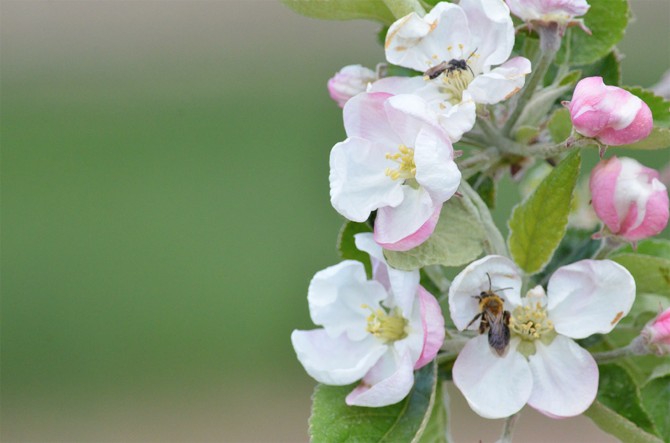Set strawberry alarm clock for post-apple bloom
By Krishna Ramanujan
Growers who time their strawberries to bloom just after apples do can reap a better harvest, according to new research.
When apple trees blossom, the sheer abundance of flowers attracts most of the pollinators, which leaves fewer bees for other nearby crops such as strawberries and lowers their yields. But if growers time their strawberries to flower directly after a neighboring apple bloom, strawberries produce higher yields than they would if there were no apple trees nearby.
The findings, published in the March 27 issue of Nature Scientific Reports, offers growers a sustainable method for boosting yields of crops that bloom around the same time as apples.
Previous research showed that strawberries can have as much as 40 percent yield increase when bees and other pollinators visit, compared with relying on wind pollination alone.
“We are trying to figure out ways that growers can use ecosystem services to promote crop yield rather than relying on external inputs, such as fertilizers and pesticides,” said lead author Heather Grab, a doctoral student in the lab of co-author Bryan Danforth, professor of entomology.
Planting natural habitats around farm fields can lead to improved health of pollinators and a boost in their services, according to research. But for many growers in agriculturally dense areas, increasing natural habitats is not an option.
“Those growers need some more sustainable agriculture options,” Grab said. “If growers pay attention to timing of when crops are blooming and manipulate that by planting apple varieties and strawberry varieties that don’t overlap, you can get a boost in yield that is almost equivalent to having natural habitat nearby.”
Growers often also use mulching systems to delay strawberry blooms.
The researchers, who conducted the study in the Finger Lakes region of Upstate New York, discovered diverse pollinator communities in the area, with at least 65 species visiting either apples or strawberries, with substantial overlap in species that visited both crops. The most abundant apple pollinators – ground nesting bees – were also the most abundant strawberry pollinators.
Grab and her colleagues set up experimental plots of potted strawberry plants in commercial strawberry fields, so they could control water, soil quality, deer herbivory and the timing of strawberry blooms. These plots were located across a gradient with apple orchards nearby in some locations and with no apples present in others. They also set up bee traps in these plots. They put out the pots of strawberries at three distinct time periods; during early apple bloom, at full-peak apple bloom, and just as apple blooms were dying out.
Future work will investigate whether this strategy also holds benefits for the pollinators, as food sources are spread out over time rather than having a large glut of food that is followed by less availability.
Co-authors included Greg Loeb and Katja Poveda, both Cornell faculty members in entomology, and Eleanor Blitzer, a biologist at Carroll College.
The study was supported by Smith Lever and Hatch funds and the United States Department of Agriculture.
Media Contact
Get Cornell news delivered right to your inbox.
Subscribe